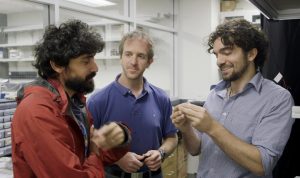
You would never think about pouring a glass of water onto your computer, right? Well, Stanford engineers have.
Manu Prakash, an assistant professor of bioengineering at Stanford, and his students have built a synchronous computer that operates by harnessing the physics of moving water droplets.

Prakash has been working on this computer for almost a decade, back when he was a graduate student.
The work combines his expertise in manipulating droplet fluid dynamics with a fundamental element of computer science – an operating clock.
“In this work, we finally demonstrate a synchronous, universal droplet logic and control,” said Prakash.
Because of its universal nature, the droplet computer can theoretically perform any operation that a conventional electronic computer can, but at significantly slower rates.
Prakash and his team actually have a more ambitious application in mind – building a computer that can influence physical matter.
“We already have digital computers to process information. Our goal is not to compete with electronic computers or to operate word processors on this,” said Prakash. “Our goal is to build a completely new class of computers that can precisely control and manipulate physical matter. Imagine if when you run a set of computations that not only information is processed but physical matter is algorithmically manipulated as well. We have just made this possible at the mesoscale.”
The technology has potential applications in scalable digital manufacturing.
(Video by Kurt Hickman, Stanford University)
It all starts with a clock
Prakash decided to build a rotating magnetic field that could act as clock to synchronize all the water droplets.
Computer clocks are responsible for nearly every modern convenience such as smartphones, DVRs, airplanes, and the Internet. Without a clock, none of these devices could operate without frequent complications. Nearly every computer program requires several simultaneous operations, each conducted in a perfect step-by-step manner. A clock makes sure that these operations start and stop at the same times, ensuring that the information synchronizes.
“The reason computers work so precisely is that every operation happens synchronously; it’s what made digital logic so powerful in the first place,” said Prakash.
A magnetic clock
The fluid-based clock needed to be scalable so that in the future many droplets can communicate with each other effortlessly. Prakash decided on a rotating magnetic field to make it work.
Prakash and his colleagues built arrays of tiny iron bars on glass slides similar to a Pac-Man maze and then laid a blank glass slide on top with a layer of oil in between. They then carefully injected into the mix individual water droplets that had been infused with tiny magnetic nanoparticles.
Next, they turned on the magnetic field. Every time the field flips, the polarity of the bars reverses, drawing the magnetized droplets in a new, predetermined direction, like slot cars on a track. Every rotation of the field counts as one clock cycle, like a second hand making a full circle on a clock face, and every drop marches exactly one step forward with each cycle.
A camera records the interactions between individual droplets which allowed observation of computation as it occurs in real time. The presence or absence of a droplet represents the 1s and 0s of binary code, and the clock ensures that all droplets move in perfect synchrony so that the system can run “forever,” without any errors.
Making it even smaller
The team’s current chips are about half the size of a postage stamp and the droplets are smaller than poppy seeds, but the team believes they can get it even smaller. Combined with the fact that the magnetic field can control millions of droplets simultaneously, this makes the system exceptionally scalable.
“We can keep making it smaller and smaller so that it can do more operations per time, so that it can work with smaller droplet sizes and do more number of operations on a chip,” said graduate student and co-author Jim Cybulski. “That lends itself very well to a variety of applications.”
According to Prakash, the most immediate application might involve turning the computer into a high-throughput chemistry and biology laboratory. Instead of running reactions in bulk test tubes, each droplet can carry some chemicals and become its own test tube, and the droplet computer offers unprecedented control over these interactions.
The results are published in the current edition of Nature Physics.
